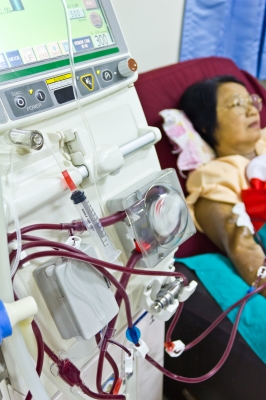Nature’s Way Vita Gummies embed vitamins in delicious sugar filled gummies. And just for good measure they have former Olympian (and now Biggest Loser host) Hayley Lewis pushing them on the teev.
Shouting about the vitamin benefits of a food while blithely ignoring the other 99.99% of the product is not a new tactic in the processed food industry. Streets want every child to get their ‘afternoon calcium’ (and Vitamin B12 and Phospherus) from their Paddle Pop Moos. They proudly proclaim every single ice-block has the calcium of ‘1 Glass of Milk’ but leave the fact that it is 20% sugar to the small print.
Nestle would rather the kids get their daily calcium (and magnesium) from its (Heart Foundation approved) Milo Duobreakfast cereal (30% sugar) or a nice (Heart Foundation approved) chocolate Billabong (18% sugar). Really health conscious kids are encouraged to get “50% of their wholegrain target” by chomping on some Uncle Toby’s Oats, So Tasty for Kids (30% sugar).
For that after breakfast snack, Kellogg’s wants you to feed your young iron-men Nutrigrain Bars and perhaps give the other kids some nice (Heart Foundation Ticked) K-Time Twists (both 37% sugar). And don’t even get me started onLCM’s (also 37% sugar) and their schoolyard commercials.
I guess you could (almost – at a very big stretch) justify that kind of marketing if there was any evidence (whatsoever) that the average Australian needed any more of those Vitamins or minerals. Vitamin supplements have only been part of our food supply since just before the second world war. Prior to that our Grandparents and their grandparents managed to struggle through life without any supplementation at all.
The need for vitamins only arose because two hideous diseases reached epidemic proportions in the early part of the 20th century. In south-east Asia beriberi was rampant because (it turned out) Europeans had started using steam driven mills to turn brown rice into white rice (and in the process stripping out Vitamin B1). And at almost the same time in the southern United States pellagra was inflicting mass agony because Europeans had decided that treating raw corn with lime (a process the Indians had used for millennia to activate the Vitamin B3) was a waste of time and money.
South East Asians derived almost all their nutrition from rice at the time and poor farmers in the southern United States derived almost all of their food from corn. Messing with those two fundamental food sources resulted in mass deficiencies which led to disease. The only other two significant deficiencies which have (in modern times) resulted in widespread disease are scurvy (if you happen to be locked in a boat without access to anything but dry biscuits and rum for six months) and rickets (if you use too much sunblock).
The reality is that the overwhelming majority of people living in Australia today have no more risk of being functionally deficient in any vitamin than I do of becoming the Queen (of England that is). Our bodies are extraordinarily efficient at extracting exactly what we need (and no more) from our food (mostly from meat) and excreting the excess. If you are inclined to the I’ll-top-em-up-just-in-case persuasion, the research suggests you are just flushing your money away.
One of the most thorough (but by no means, not the only) recent studies was the Physicians Health Trial. In that study, 14,641 US doctors were followed for 10 years while they took either Vitamin E or Vitamin C supplements, the two vitamins which are heavily promoted as having anti-oxidant (and therefore heart disease related) benefits.
Half of the doctors were actually taking placebos instead, but neither they nor the folks assessing the results knew which was which. The double blind (no-one knew who was taking what), randomized nature of the trial (together with its large size and long duration) means that it is very high quality evidence.
The point of the trial was to figure out whether the supplements had any effect at all on heart disease and stroke outcomes among the participants. And what they found would have been very disappointing for the supplement industry indeed. There was exactly no difference between the heart disease outcomes for any of the groups.
The Vitamin E folks had just as many heart attacks as the Vitamin C folks. And they had just as many as the folks taking nothing. The resounding conclusion from the study is that if any of the participants had been paying for their vitamins, they would have been well and truly wasting their money (for ten long years). While we certainly need Vitamin E and Vitamin C, it seems shoving more of it in our mouths changes absolutely nothing (except the bank balance of the folks selling the supplement).
Similar high quality trials on Vitamin D, Calcium and Vitamin B supplements have arrived at exactly the same conclusion – don’t waste your money. And as the makers of Berocca have just discovered, making claims to the contrary can get your expensive advertising campaign banned.
Despite our extraordinarily efficient efforts at mining food for nutrients, we can damage our ability to use the vitamins and minerals we do absorb. Sugar consumption interferes with copper metabolism which can result in impaired muscle growth (in children) and problems with vein and artery wall formation. It also leads to impaired iodine absorption (and therefore thyroid hormone production) and degrades our Chromium stores (which leads to insulin resistance and Type II diabetes) just to name a few of its more delightful features.
Vita-Gummies (at 23c a throw) are about 8 times the price of garden variety gummi bears (which are aren’t laced with precursors to expensive urine) but they do contain just as much life sapping sugar (something which unfortunately ends up around our waist and not down the drain).
Selling ice-creams and lollies as health food (to children and their parents) when they are in reality a package of pure sugar is unbelievably perverse. Engaging the services of Hayley Lewis’ hard earned reputation to do it is just plain deceptive.
Unfortunately nobody is breaking any laws telling us that a sugar loaded sweet (with a vitamin chaser) is good for us. And so the marketers go to town. But where do we draw the line? Chocolate coated carrot shavings, sold as Vegies the Kids Will Love (no, Nestle that is not a suggestion)? This pathetic game must stop. It’s time for truth in labelling. Surely our children are worth that much.
The Heart Foundation has finally trashed the last of its credibility.
Last week, (an ecstatic) Nestle announced that it had secured a Heart Foundation tick on 44 of the 46 breakfast cereals it sells in Australia.
The line-up of tick-approved products will now include some of the highest sugar breakfast cereals on sale in Australia. Milo and Milo Duo (both 29.7% sugar), Uncle Toby’s Oats Temptations (up to 34% sugar) and Uncle Toby’s Healthwise for Heart Wellbeing (30% sugar) will join the Kellogg’s Just Right (31.1% sugar) on the list of cereals the Heart Foundation says you should be eating.
The only two Nestle breakfast cereals now lacking the tick of approval are Nesquick (31.7% sugar) and Uncle Toby’s Plus Protein Lift (25.3% sugar). But don’t worry they’ll both be tickety-boo in no time. They’re currently being “reformulated”.
Nestle won’t have to worry about reducing the sugar content while it is reformulating. You see, the Heart Foundation doesn’t care about the sugar content of a tick-approved product.
A fan of my blog shared some his correspondence with the Heart Foundation this week and it revealed some interesting insights into the process.
The Heart Foundation said:
“Sugar is not a criterion because added sugar and natural sugars have similar effects on the body and based on the current level of evidence, sugar is not directly linked to [heart disease], diabetes, or obesity.”
Which is a really odd stance to take because even the briefest glance at the scientific literature would reveal that the cup of evidence against sugar runneth over.
Take for example the recent review of the evidence (published in theAnnals of the New York Academy of Science), which concludes:
“…recent data suggests that fructose consumption in humans results in increased [stomach fat], [fat] dysregulation, and decreased insulin sensitivity, all of which have been associated with increased risk for [heart] disease and type 2 diabetes.”
Perhaps the Heart Foundation forgot to renew its journal subscriptions because its “evidence” proves sugar is not dangerous. If (by evidence) you’re thinking about an extensive literature review (oh say, like the one I just mentioned), you’d be unfulfilled. If you’re thinking about a series of population studies, disappointment is in your future. Even if you’re thinking of a single rat study, you’re aiming too high.
No, the Heart Foundation’s “evidence” appears to be a single graph. The (unattributed) graph shows an increasing trend of obesity plotted against a decreasing trend of sugar consumption. There’s no sign of any evidence about heart disease or diabetes, but perhaps we just have to take those on faith.
Under further questioning, the Heart Foundation revealed to my correspondent that the source of the graph was the research conducted by Alan Barclay (the chap who helps the folks slapping low-GI stickers on packets of sugar). They referred him to theDietitians Association press release about Dr Barclay’s study for confirmation.
Unfortunately, Dr Barclay’s paper has not been published, so figuring out how he arrived at the graph is a little difficult. Just about the only thing that is clear is that the graph produced by the Heart Foundation bears no relationship to the data on sugar availability (there is no current consumption data) from the Australian Bureau of Agricultural and Resource Economics (a government department).
ABARE seems to think that Australian domestic sugar availability has gone the way we might have expected it to (from about 45 kilograms per person in the mid-‘80s to about 62 kilograms per person in 2009).
But even if the Heart Foundation’s graph was entirely correct, what would it prove? Well, nothing really. No one is suggesting that sugar consumption today results in instantaneous population-wide obesity.
The science says that (one of the ways) fructose makes us fat is by interfering with our appetite control over decades of continuous consumption. The cumulative effect of this is steadily increasing weight and concurrent metabolic dysfunction (which make us prone to Type II Diabetes and Heart Disease).
The increase in obesity statistics we are seeing now is likely to be a result of the appetite disruption (caused by sugar) between the Second World War (or even earlier) and now. So comparing today’s obesity statistics with today’s consumption is a pointless academic folly (even if it were accurate).
That would be rather like looking at this graph of lung cancer death versus cigarette consumption in 1980 and concluding that there was no correlation (because the lines had gone in opposite directions since 1960). But this is exactly the scientific method that the Australian Heart Foundation has deployed in justifying its stance (that sugar is not a relevant criteria for its tick program).
That’s not just bad logic, it’s not even bad science, it’s just straight out deceptive. I guess this all raises the question, why would anyone (least of all the Heart Foundation) be attempting to prove we eat less sugar now? One glance at the local supermarket (especially the breakfast cereal aisle) will tell us that is patent nonsense, so what would motivate someone to suggest it is so?
I hope it’s not just the lousy few million smackeroos the foundation makes every year from this little jape. Because if that’s the sole motivation behind this pathetic denial, then it is a dreadfully low price to pay for the health of a nation. The cynical lawyer in me suspects somewhere, somehow, someone is making real money out of this, but the father in me just wants the deception to stop — now.
It’s January, the month of the diet. Prepare to have the secret of weight loss bestowed upon you every time you pick up a newspaper. But the reality is we have no more chance of losing weight on a ‘diet’ than we do of flying by flapping our arms.
No matter how special we’d like to think we are, when it comes to our body, we are just mammals. Ok we’re pretty bright mammals (well you are, if you’re reading this). But for all that braininess, the carcass we walk around in is 100 per cent pure mammal.
Just like every other mammal, we have a sophisticated mechanism for making sure we keep functioning. On auto-pilot, we keep our heart beating, our lungs pumping and our temperature stable. We also ensure that our brain (and every other cell in our body) has exactly enough fuel to perform at its best (regardless of what’s going on in the outside world). None of this requires a moment’s thought (literally).
The control system for all of these (and infinitely more) processes is our hormones. Hormones tell our bodies when (and how much) to grow. They tell (some of) us when to prepare for making babies. And they control how much fat we store (and where we store it).
We can’t control our hormones with will power (or any other conscious thought). We can no more think ourselves taller (or shorter) than we can think ourselves a lower body temperature.
A child grows because hormones tell every (relevant) part of the child’s body to grow. The hormones instruct the cells to demand more energy and other hormones accommodate the demand by up-regulating appetite control. The child eats more and has the building blocks for growth. The growth drives the appetite, not the other way round.
The science is now abundantly clear that another type of growth (this time horizontal) is also hormone driven. Our appetite control hormones are exquisitely balanced to ensure we have just the right amount of energy on hand.
But when that balance is disrupted, our fuel management system can veer wildly out of control. A disrupted appetite control system can store too little or too much fuel. Too little looks like anorexia, too much looks like, well, most of us. Obesity is a symptom of a failure of the balance of hormones controlling how much food we take in.
This hormone dysfunction causes us to store too much fat in our cells, but the body is not aware the fat is there and keeps demanding food. Our appetite control system thinks we are starving even while we have more than enough fat being packed away (usually in very unsightly places).
A growing child can’t fight hormone driven appetite demands with willpower. And we can’t control weight gain with willpower either.
When an obese person restricts the amount of food they eat, they are not changing the underlying error in the appetite control system. The body thought it was starving before the diet, now it’s really starving. It will not use the fat store to satisfy its need for food because the hormonal disruption means it doesn’t even know it’s there.
The hormones will force the body to sacrifice muscle and even organs to make up for the missing calories. And the whole time, the dieter will feel like they are starving to death. No wonder no-one can stay on a diet (long term).
Obesity is a symptom of appetite control dysfunction, but it is not the only one. Heart disease, type II diabetes, kidney disease and dementia (to name just a few) are all symptoms of the same underlying disorder. And just like symptoms of any disease, not everybody has all the symptoms appear at the same time.
Not all Kidney disease suffers are obese (but most are). Not all heart disease victims are obese (but most are). And 15 percent of Type II Diabetes suffers are not overweight.
We are frequently told that the ‘cure’ for most of these diseases is cure the ‘disease’ of obesity (and the way to do that is to eat less and exercise more). But that is the same as being told to take panadol to ‘cure’ a toothache. It will (temporarily) eliminate (or reduce) a symptom, but it does absolutely nothing for the underlying cause.
Recent studies have proven beyond doubt that we can induce all of the symptoms of appetite hormone disruption in humans by simply feeding them the fructose half of sugar. The cluster of ‘symptoms’ of the fructose appetite disruptor is currently costing our health system more than $60 billion (three times our defence budget) a year. And it is costing individuals much more than that (in quality of life) every single day.
But so far there is no sign that those in charge of our health dollars are prepared to look any further than the ‘panadol cure’.
The plan is to keep telling fat people they are fat because they make ‘poor choices’. The plan is to tell people to control hormones with willpower. And the plan is (apparently) to continue to support the explosive growth of industries which take our money to ‘cure a disease’ (when all they are doing is masking a symptom).
Lap-banders, shake-sellers, liposuction merchants and wellness providers will continue to lobby government for more and more public money. And (when they give in) health bureaucrats will justify the expense with (increasingly) bellicose demands that we trim down. But the science says we can expect that Plan to have just as much success as it has in the last four decades (during which overweight and obesity rates have doubled).
A change of course will be a great embarrassment to many eminent ‘health professionals’, but change course we must. So as you flip through the avalanche of calorie reducing diets from the New Year health gurus remember panadol doesn’t cure rotten teeth. And we will not cure obesity until we start treating it as a symptom rather than a disease.
The fructose half of sugar causes irreversible cellular damage. And this damage may just be the thing which links most of the diseases of the Western World (oh, and makes us prematurely elderly as well). But there is a way to limit the damage. No its not a drug (although plenty of people are trying to find one). All you have to do is stop eating sugar.
Enzymes control chemical reactions in our body. If we need a sugar (like glucose or fructose) to be attached to a protein for some purpose, the appropriate enzyme will make sure the sugar gets attached to exactly the right part of the protein (or fat). The process of attachment is called glycosylation and we are only just beginning to understand the enormous array of uses our body has for glycosylated proteins (such as fending off disease and even inhibiting the development of Type II diabetes).
It is however possible for sugars to accidentally attach themselves to proteins without an enzyme’s help. When that happens, the process is called glycation. Glycation can result in sugars being attached in all sorts of unpredictable (and haphazard) ways.
Glycation happens by accident and is really only likely to happen when our blood sugar levels are high (the more sugar molecules there are floating around the more likely some of them are likely to crash into a protein). The good news is that in normal circumstances glycation is reversible. As soon as blood sugar levels drop, most of the sugars and proteins will disengage and no harm is done.
But if blood sugar stays high (as is the case with someone who is diabetic or pre-diabetic), the sugar-protein combo will undergo a series of reactions that will result in the creation of an Advanced Glycation End-product (AGE).
All sugars can form AGE’s, but the glucose half of sugar is the least reactive of all sugars. This is a good thing because it is the primary sugar in our bloodstream. The bad news is that the fructose half is ten times more reactive than glucose.
Eating sugar gives us a big shot of fructose and a big (and immediate) increase in AGE production. Making things much worse, fructose consumption also leads to an increase in insulin resistance. Over the long term the insulin resistance creates an environment where our blood glucose levels are persistently elevated. And this creates a second major source of AGE’s.
If your doctor suspects you of being diabetic, they will often test your HbA1c (or A1c for short) level. The test measures the level of a glycated form of haemoglobin (the protein which transports oxygen in your blood). A high A1c level indicates that there are significant AGE levels. That is taken as a sure sign that your blood sugar is persistently too high.
Our body’s are used to garden variety (glucose-produced) AGE’s. And we are pretty good at breaking them down and disposing of them. But even so, over time they accumulate in our organs and tissues and we, well, age (the acronym AGE is very much on purpose).
Unfortunately the AGE’s made with fructose molecules are resistant to our disposal system. So not only they made at 10 times the rate, they hang around like John Farnham on a comeback tour.
AGE’s are junk, litter on our body’s interstate highways. But this is not a burger wrapper chucked out the window. This is more like the (exploding) roadside litter our troops encounter in Afghanistan. AGE’s are dangerous because they bond easily (and randomly) to each other and to other proteins in a process called cross-linking.
AGE’s accumulate pretty much everywhere in the body, but in some places they do much more damage than others. When they pile up in the lens, cornea and retina of the eye they result in cataracts and macular degeneration (the leading cause of blindness in Australia). They also accumulate in the fine tubules of the kidneys – resulting in loss of kidney function.
They cross-link the collagen which otherwise gives our arterial walls (and our skin) their elasticity (hence the term, hardening of the arteries and the ‘aging’ of the skin). They cause the oxidation of LDL cholesterol particles, making them much more likely to become trapped in arterial walls (leading to heart disease and stroke). And they accumulate in the brain.
Neurons ideally last a lifetime. This means they are much more likely to accumulate AGEs. When researchers start looking at the tangles of twisted proteins which accumulate in the neurons of Alzheimer’s patients, they discover AGEs in abundance. This is likely to be the reason why other researchers have picked up on the association between Alzheimer’s (and other dementia) and high blood sugar.
Observational and controlled studies have linked fructose consumption to Type II Diabetes, Heart Disease, stroke, blindness, kidney disease and even Alzheimer’s (to name just a few of the more delightful ones). AGE research has come a long way in the last decade (and is still in its infancy), but it might just provide a unifying mechanism which explains why the incidence of these diseases is exploding in the Australian population – we eat way too much fructose.
So if aging slower (than you otherwise might) will be top of your to-do list in the New Year, you could buy a tub of hand cream sourced exclusively from the sweat of left-handed, French, mermaids – or you could just ease back on the fructose this Christmas.

I don’t know of anyone who brings as much passion to the obesity problem as Jamie Oliver. He has a talent for whipping (normally docile) politicians into action for a good cause. It’s just a pity the advice Jamie is dispensing is so unlikely to change anything.
Last month, Jamie Oliver announced his first foray into correcting the diets of Australians. He plans to set up his ‘first’ Australian Ministry of Food (MoF) operation in Ipswich, just outside sunny Brisbane. The Ipswich MoF will host classes which allow up to 14,000 folk a year to sign up for (what is essentially) a home economics class once a week (over 10 weeks). The punters pay $10 for the lesson but they get to keep whatever they cook (not necessarily an advantage in my case).
Jamie’s MoF Australian ‘manifesto’, tells us that there will be an “extra 6.7 million obese Australians by 2025” and this demonstrates “an urgent need for action!” The cause (according to the Naked Chef) is that we have “a complete lack of cooking knowledge.”
Apparently cooking skills “used to be passed down” but now “women go out to work” and we no longer have compulsory cooking lessons in school. So “about two generations” have missed out on acquiring cooking skills. In a nutshell, Jamie believes that “there’s a serious lack of knowledge about food and cooking, and the result is the modern-day epidemic of obesity and bad health.”
But, will teaching “single parents, young mothers, teenagers, families and older people” to cook, fix the problem? Many more Australians (around 4 million on a good night) than will ever darken the door of Jamie’s MoF have been learning to cook over the last few years. They’ve been watching a little show called Masterchef. And just in case you don’t think anyone is paying attention, a quick look at Coles’ cash register receipts will swiftly change your mind.
The company’s sales data (as reported by Smart Company) reveals that it achieves massive sales increases on everything from pistachios (up 125%), red cabbage (up 89%) to fillet steak (up 56%) the day after the ingredients feature on the show. And the drive to cooking your own food is much stronger and deeper than that. Coles attributes much of its sales growth to people discovering that it’s cheaper to eat at home than in a restaurant (who knew?).
But figures released yesterday suggest that all that home cookery has had no visible effect on our trouser size. The Health of Queenslanders report shows 61 per cent of adults (an increase of more than 14 per cent in the preceding eight years alone) and 26.9 per cent of children in Queensland are now obese or overweight.
In 2009, Jamie established the first MoF in the Yorkshire town of Rotherham and shortly afterwards opened shop number two in nearby Bradford. The aims (and the ‘manifesto’) were almost identical to the Aussie version (which will be the third site in the world).
Rotherham was set up as part of a TV Series and then funded (to the tune of £130,000 a year) by the British Government (for two years). Bradford is costing the local council £120,000 a year. And while thousands of people have attended learn to cook classes in both places, Rotherham is clearly not convinced it’s worthwhile. In September, the government refused to commit to renewing the funding when it expires in March 2011.
There’s no obvious scientific foundation to Jamie’s claims. He doesn’t cite any studies of the relationship between cooking skills and obesity (or indeed any science which might support his case at all).
There is however plenty of science to say that sugar consumption is the cause of obesity (and much much more). Just yesterday, yet another in a long line of studies was released. This one, published in the prestigious Journal of the American Society of Nephrology reviews the recent clinical and experimental evidence and concludes that excessive amounts of fructose (one half of sugar) plays a significant role in high blood pressure, diabetes, obesity, and chronic kidney disease.
More than three quarters of the sugar we eat is buried in foods we would never attempt to make ourselves. Soft drinks, Breakfast Cereals, Muesli Bars, Confectionary and packages sauces and condiments. And nothing about Jamie’s program will change that reality.
Oliver’s ‘home ec’ teachers are not showing us how to replace the softdrink (or fruit juice) we have with the home cooked meal or the packaged breakfast cereal (or muesli bar) we feed the kids. They’re focused on Carrot Salad and Lemon Rice.
When Jamie does stray out of the salad aisle, things get pretty sugary, pretty fast. The Mega Chocolate Fudge Cake (featured in the Ministry of Food TV Series) serves up 120g (30 teaspoons) of sugar, 200g of Chocolate and 100g of Fudge.
There’s no plausible reason why cooking something yourself would result in weightloss and there’s no credible evidence that it does. But that hasn’t stopped the Queensland Government handing over 2.5 million taxpayer dollars to set up the MoF in Ipswich.
Jamie Oliver might as well be telling us that wearing a foil hat will reduce our waist size for all the effect the MoF is likely to have on obesity. And that’s a pity.
Oliver is a blur of energy, with an extraordinary ability to prise open government coffers in the name of health. Imagine what could be achieved if his efforts were backed by science.
Image by really short from NYC, USA (Jamie Oliver in Union Square) [CC-BY-2.0 (http://creativecommons.org/licenses/by/2.0)], via Wikimedia Commons
The science is now very clear. Sugar consumption causes type 2 diabetes. But our governments persist with programs that try everything except removing sugar from the diet. Is it any wonder we are being overwhelmed by a diabetes epidemic?
The Treasurer’s Intergenerational Report (released in February) soberly warned that treating diabetes must be a financial priority. Treasury estimates that by 2032-33, “Costs from diabetes alone are projected to increase 436 per cent, from $1.6 billion to $8.6 billion.”
Diabetes Australia thinks that (scary as they are) those numbers are likely to be a vast underestimate. They reckon almost 15 percent of the population already suffer from Type 2 diabetes (or pre-diabetes). Worse still, those numbers are going in only one direction – up, big time.
Governments haven’t been sitting on their hands waiting for the diabetes tsunami to wipe out the health system. In 2007, the Council of Australian Governments decided to spend $204 million to reverse the significant growth in type 2 diabetes. The Commonwealth Government announced that it would focus the funding on people at high risk of type 2 diabetes using something called “Subsidised Lifestyle Modification Programs” (SLMP).
Despite the disturbing name, the idea was that when GPs identified an ‘at risk’ individual they’d be told to go and get a SLMP. The SLMP involved accredited allied health professionals providing nutrition and exercise information designed to steer the punter away from becoming a diabetic.
Well the results are now starting to come in, so how did the SLMPs go?
The Health Department’s review of the program for the 2009-10 tax year concludes that uptake of SLMPs is “below the level anticipated.” Ya think? – just 680 people (out of an expected 45,500) bothered. I think we can safely conclude the government’s big gun in the war on diabetes has turned out to be somewhere between wishing and hoping on the scale of effective disease prevention measures.
But that may just be a good thing (or at least not a bad thing), because the evidence is that nutrition advice delivered in accordance with the current national guidelines is completely ineffective. A paper released by the Australian Productivity Commission this month concluded government funded childhood obesity (a strongly associated risk factor for diabetes) interventions to date “have not been effective in stabilising or reducing obesity prevalence to any significant degree.”
So it’s timely that last week the Harvard School of Public Health published the results of its meta-analysis of the research on the relationship between sugar sweetened drinks and diabetes. They reviewed eight high quality studies which involved 310,819 participants and 15,043 cases of Type 2 diabetes. Each of the underlying studies was significant in its own right and all had been concluded between 2004 and 2010.
All but one of the studies revealed a strong (and significant) association between sugar and diabetes. Taken together they showed that consuming one or more soft drinks (or fruit drinks or vitamin waters) per day would increase your chance of contracting type 2 diabetes by 26 per cent.
As convincing as this meta-analysis is, it just confirms what a very strong series of studies (on the link between soft drinks and diabetes) have been saying for over six years now. But the research has recently gone much further than mere population level correlations.
Last year researchers at the University of California fed volunteers diets supplemented with fructose drinks (the dangerous half of sugar). The result was a 20 percent decrease in the effectiveness of clearing the glucose out of the bloodstream – step one on the Type II Diabetes treadmill. And other recent studies have shown that when carbohydrates (including sugar) are pulled out of the diet, Type II Diabetes symptoms are actually reversed.
But if that wasn’t enough, there is even more powerful evidence of a link. Nestle Australia and CSR Sugar both go out of their way to say exactly the opposite. CSR says “There is no evidence that eating sugar causes diabetes” and Nestle chimes in with “eating sugar doesn’t directly cause diabetes.”
The Californian study lasted just 10 weeks (and clearly longer term studies are needed) but taken together with last week’s meta-analysis, red flags are waving all over the place. Sugar consumption creates type 2 diabetics. It shouldn’t come as much of a surprise then that as our per person sugar consumption soars past 1 kg per week, type 2 diabetics are being minted at the rate of 275 per day (and counting).
In the face of a deadly epidemic (accelerating at epic proportions) why do our healthy eating guidelines persist in advising that there’s nothing wrong with a diet that’s 20 percent sugar? Why won’t you find any warnings about not eating fructose on the Diabetes Australia website? And why is the Australian Diabetes Council saying it wants to “end the myth that sugar causes diabetes.” (!)
Besides being our 6th biggest killer, type 2 diabetes is the most common cause of blindness (for people under the age of 60) and responsible for more than 9 limb amputations a day in Australia.
Luckily, the science says this dreadful disease can be stopped easily – just eliminate sugar from the food supply. So how about we pay attention to what the science is (repeatedly) telling us and give that a go before we waste more time and money on interventions that patently don’t work?
The week before last, I said that dietary advice emanating from Australia’s “peak body of dietetic and nutrition professionals” (the DAA) needed to be treated with caution. I pointed out that the DAA is the recipient of significant sponsorship from the food industry. I went on to say that this may inevitably lead to (at least the perception of) a conflict of interest.

The Dietitians Association of Australia (DAA) is just like a union for dietitians. And like all unions, its priority is to represent the interests of its members. So when it starts handing out advice on what to eat we should be cautious. We should be especially cautious when that advice is funded by some of Australia’s most powerful food companies.
In Australia there is nothing to prevent anybody declaring themselves to be a dietitian (or a nutritionist). The barrier to entry is the price of a stack of business cards.
Other professions have managed to protect themselves (and their customers) by requiring qualifications and the observation of professional standards. Some professions have even managed have the barriers enforced by law (because when a lawyer or a doctor stuffs up the results can be catastrophic).
One of the primary roles of the DAA is to perform this ‘professional’ function for dietitians. It has created a certification process which produces Accredited Practising Dietitians (APD). And it has successfully lobbied to ensure that Medicare and private health fund rebates are only payable for APD services. In short their message is, make sure your dietitian is an APD.
One of the main sources of work for APDs is referrals from doctors (often just after they diagnose you with pre-diabetes and advise you to adjust your lifestyle). The nature of the work is telling people what they should eat. So a food company would be mad not to help the DAA. And help they certainly do.
The DAA’s list of corporate sponsors reads like a who’s who of the Australian food industry. Kellogg’s, Nestle, Unilever (the maker of Street’s Ice Cream and Flora margarine to name a couple of its brands), Nutricia (baby formula makers), Jalna yoghurts and the Meat and Livestock Association all feature prominently on the list of corporate ‘partners’.
That corporate support is significant. The DAA’s annual report reveals that (in 2009) advertising and sponsorship ($686,249) was the third largest source (after membership dues, $1.5m and seminar fees $833k) of revenue for the association. If the money from the food industry weren’t there, it’s likely each of the 4,100 members of the DAA would be facing considerably higher fees.
The DAA’s partners help with much more than mere cash. For example, Kellogg’s is a big supporter of the DAA’s (or is it the other way round?) National Breakfast Week, a campaign to ensure we eat breakfast (guess what features prominently). Kellogg’s also helps run the DAA Media Program, which “seeks to provide accurate nutrition and health information to the Media.”
The DAA’s policy on accepting sponsorship is that it “will not be influenced in any statements, positions or opinions by its commercial agreements.” And we would expect no less, but the same policy adds a somewhat cynical twist by saying that that DAA will take on sponsorship only where the “benefits for DAA outweigh any assessed risks.”
The fructose half of sugar is a dangerous (and addictive) addition to our diet that helps to sell many of the products made by the DAA’s corporate supporters. So what is the DAA’s position on sugar?
In May this year, a DAA press release trumpeted “Sweet truths: Eating sugar may not make you fat.” The release reported on a ‘study’ presented to DAA’s annual conference by DAA spokesperson, Dr Alan Barclay.
Dr Barclay reported that “consumption of fructose has decreased by nearly 20 per cent in Australia since the early 1970s, while overweight and obesity has doubled.” He went on to say “Much to everyone’s surprise, it looks as if, unlike in the US, sugar is not the culprit here …”
What the DAA’s press release did not say was that Dr Barclay is employed by Glycemic Index Ltd, an outfit that collects a royalty on CSR sugar sales. The DAA also neglected to mention that the sugar consumption figures presented by Dr Barclay stand in stark contrast to similar numbers maintained by the Australian Bureau of Agricultural and Resource Economics (a government department). ABARE seems to think that Australian domestic sugar consumption has more than doubled since the mid-eighties.
I suspect Dr Barclay would say his employer’s relationship with CSR doesn’t influence his view of the science about sugar. And I’m sure the DAA would say the same about all of its sponsors. But I prefer messages about the safety of sugar not to be sponsored by the folks who make billions out of selling it.
Australians don’t like people in positions of trust accepting kickbacks. We constantly worry whether drug companies are trying to influence our doctors. We demand that lawyers refuse to act on both sides of a real estate purchase. And we even get our undies in a twist at the thought of our PM accepting a dodgy ute.
We trust the DAA (and our Medicare and health insurance premiums pay its APD’s) to tell us what to eat. In that context, accepting significant payments from the food industry is a flagrant conflict of interest.
I don’t know whether the DAA just hasn’t caught up with its reading on sugar or whether the money is colouring its advice. But the existence of significant food industry sponsorship should cause all Australians to discount anything the DAA says about nutrition. And that is a disgraceful state of affairs for Australia’s “peak body of dietetic and nutrition professionals.”

What will put the most Australians in hospital this year? Car accidents? No way. Heart attacks? Nup. Cancer? Not even close. No, it’s Kidney Disease. But a series of recent studies suggest there is a very simple way to turn that statistic around.
Chronic kidney disease is now responsible for more than 1 in every 7 hospitalisations. And that rate has gotten very bad, very quickly. Between 2001 and 2008, hospital admissions for kidney dialysis alone increased by 71 per cent.
The news is even worse for indigenous Australians. At the end of 2007, they were being treated for kidney disease at six times the rate of the rest of the Australian population. This is why the number hospitalisations in the Northern Territory increased by an incredible 120 per cent (almost 20 per cent per year) in the same period.
The NT has another interesting claim to fame (aside from Croc Dundee). According to Coca-Cola it has the highest per capita consumption of Coke in the world. Increasingly the science is starting to suggest that is more than a mere co-incidence.
We don’t know what causes most forms of kidney disease and we certainly can’t cure it (other than by replacing the kidneys). But there is a line of studies going back over half a century that suggest the answer (to the mystery of the cause and the cure) might lie in something called uric acid.
Uric acid is a waste product created when we digest red meats. Like most waste products circulating in our blood stream, it is removed from our systems by our own little pool filter system, the kidneys.
Simply put, the theory goes that if you have too much uric acid, you end up clogging the filters in the kidneys and (over time) this degrades their capacity to work at all. There’s a line of rat studies you couldn’t jump over to prove exactly that cause and effect relationship. But rats process uric acid differently to humans (and other higher primates) so there’s always been a question mark about those studies.
In 2008, a major study conducted by the Vienna University went a long way to answering the question in humans. In that study 21,475 (initially) healthy subjects were tracked for 7 years. Their uric acid levels were compared to the occurrence of kidney disease. The outcome was an unequivocal correlation. The higher a person’s uric acid levels, the higher their likelihood of developing kidney disease. Full stop.
If eating meat was the major cause of increased uric acid production, you’d expect to see a steep increase in the amount of meat we eat over the last few decades (to go along with the sharp rise in kidney disease). But according to the CSIRO, our red meat consumption has been steadily falling since the 1970s.
It turns out though, that there’s another truly excellent way to increase the amount of uric acid in a human’s bloodstream. Feed them sugar.
In 1989, the US Department of Agriculture’s carbohydrate research team proved that they could cause a significant spike in uric acid levels just by feeding people the fructose half of sugar (it is half glucose and half fructose) at the levels (then) normally consumed by the average US citizen (20 per cent of calories – exactly the same as the current Australian suggested intake).
A much larger 2008 study of 4,867 US school children (unsurprisingly) found the same strong association between increased sugary drink consumption and uric acid levels. And an analysis published in the same year took that further by linking sugary drink consumption with the onset of kidney disease in adults using a similarly large database of results.
Uric acid is a by-product of the way our livers metabolise fructose. And unlike meat, sugar (and therefore fructose) consumption figures have all been one way traffic (up, big time) in the last five decades.
While all of that evidence is strongly persuasive, it isn’t proof. No-one has purposely fed a large group of people fructose (and kept it away from a similar group) to see which ones died of kidney disease first. But I rather suspect, sadly, we are inadvertently conducting our own little experiment on the indigenous population.
Aboriginal and Torres Strait Islanders consume around twice as much sugar-sweetened soft drink as the rest of us (which is very high because Australians are in the top ten per capita consumers in the world anyway). So (given their high indigenous population) it’s no wonder the Northern Territory featured so prominently in Coke’s statistics. And it’s even less wonder (given what the science is saying about fructose) that it features so prominently in our kidney disease statistics.
Kidney disease is massively debilitating. The only effective ‘treatment’ is getting hooked up to a dialysis machine three times a week. Meanwhile the number of people needing that treatment is growing at the rate of 6 per cent every year.The only ‘cure’ is replacing the kidneys (if you’re lucky enough to get to the head of the transplant queue (currently the wait is about four years) before you die.
Kidney disease is now killing more Australians than either breast or prostate cancer and more than twice as many as die on the roads every year. But the evidence is mounting that there is a very simple preventative measure. Don’t eat (or drink) sugar.
So how about we give that a go before the next generation destroys their kidneys too?
Image courtesy of bejim / FreeDigitalPhotos.net










Recent Comments